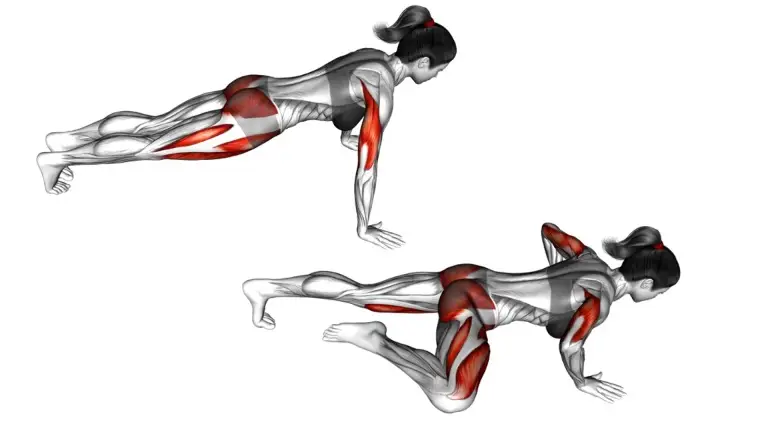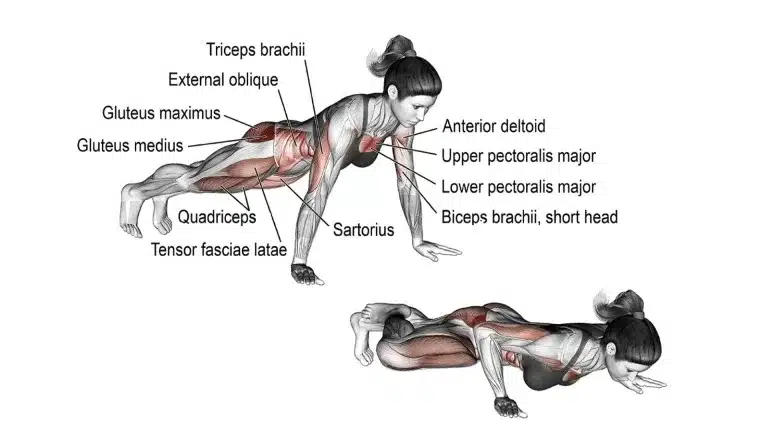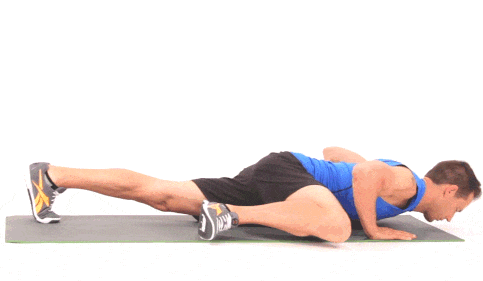Want to add some extra fun and challenge to your push-up routine? Spiderman push-ups are a unique variation that will test your strength, balance, and coordination.
This intense exercise targets not only your chest and triceps, but also engages your core, shoulders, and back muscles.
Keep reading if you’re interested in learning more about the spider push-up and how to incorporate it into your workout routine.
In this beginner guide, we will teach you how to do Spiderman push-ups correctly.
You’ll learn the muscles worked, the steps to follow, and common mistakes to avoid.

- What Is Spiderman Push-Up
- Muscles Worked During Spiderman Push-Up
- How To Do Spiderman Push-Up
- Recommended Number of Reps and Sets
- Tips and Technique For Doing Spiderman Push-Ups
- Benefits of Spiderman Push Up
- Variations and Modification of Spiderman Push Up
- 1. Spiderman Plank
- 2. Walking Spiderman Push up
- 3. Elevated Spiderman Push Up
- How To Add Spiderman Push-Ups Into Your Workout Routine
- Spiderman Push Up Alternatives
- 1. Incline Push-ups
- 2. Regular Push-ups
- 3. Push-up with knee tuck
- 4. Plyometric Push-ups
- 5. Medicine Ball Push-ups
- FAQs
- Are Spiderman push-ups hard
- How To modify Spiderman push-ups
- Takeaways
What Is Spiderman Push-Up
A Spiderman push-up is a variation of the traditional push-up exercise.
This exercise targets the muscles used in a standard push-up (like the chest, triceps, and shoulders) and engages additional lower-body muscle groups due to its unique movement.
The exercise is named after the superhero Spider-Man, as it resembles how he moves in comic books and movies.
In addition to working the upper body muscles, the Spiderman variation also works the hip flexors and other stabilizing muscles in the lower body.
The act of bringing your knee towards your elbow significantly engages your core muscles, particularly the obliques.

Want to take your gains to the next level? Discover your daily calorie needs with our free TDEE calculator
Muscles Worked During Spiderman Push-Up
The Spider-Man push-up is a compound exercise that targets multiple muscle groups, including:
- They primarily work the chest muscles (pectoralis major and minor), as well as the triceps and the shoulders (deltoids).
- They also engage the core muscles and back, as they help to stabilize the body during the exercise.
- Furthermore, it is worth mentioning that the legs and glutes are worked as you bring your knee to your elbow.

Here’s how these muscles are engaged during the Spider Push-up:
- Chest muscles: These muscles are responsible for pushing the body up and down.
- Triceps: The triceps are responsible for extending the arm.
- Core: The oblique muscles in the core are targeted during the twisting motion of the exercise.
- Shoulders: The shoulders and rotator cuff muscles are worked as you hold your body in the plank position and perform the push-up motion.
- Back: particularly the lower back muscles, are engaged.
- Glutes and legs: As you bring your knee to your elbow, your glutes and legs also stabilize your body.
How To Do Spiderman Push-Up
- Start in a traditional push-up position with your hands placed slightly wider than your shoulder width and your feet hip-width apart.
- Your body should form a straight line from your head to your heels.
- Engage your core and keep your head neutral, looking slightly ahead of you.
- Bend your elbows and lower your body towards the floor.
- Keep your elbows at about a 45-degree angle from your body.
- As you lower your body, simultaneously lift your right foot off the ground, and bring your right knee towards your right elbow.
- Your knee should come to the outside of your elbow, paralleling your thigh to the ground.
- Push through your hands to raise your body back to the starting position.
- As you do this, straighten your right leg back to its original position.
- On the next repetition, repeat the movement with your left leg.
- As you lower your body, lift your left foot off the ground and bring your left knee towards your left elbow.
- Keep your core engaged your back straight, and avoid sagging your hips.
- Inhale as you lower your body and exhale as you push back up.
- Continue alternating legs for each repetition.
- You can set a target number of repetitions or do as many as you can with good form.

Recommended Number of Reps and Sets
The recommended number of reps and sets for the spiderman push-up will vary based on your fitness level and goals.
However, as a general guideline:
- Beginners: Start with 2–3 sets of 5–8 reps on each side. Focus on proper form and technique, rather than speed or number of reps.
- Intermediate: Increase the number of reps to 10-15 and the number of sets to 3-4. Start to add more variations of the exercise and use weights to increase the difficulty level.
- Advanced: Aim to do 3–4 sets of 15–20 reps on each side. Mix up the exercise with different variations and use weights to challenge your body.
You can adjust the number of reps and sets based on your personal fitness level and goals.
Additionally, make sure to progress gradually and not do too much too soon.
Tips and Technique For Doing Spiderman Push-Ups
By following these tips and focusing on proper form and technique, you can get the most out of the spiderman push-up and avoid injury.
Maintaining proper form is crucial when performing the spiderman push-up.
- Keep your core tight and your body in a straight line throughout the exercise to avoid arching your back or letting your hips sag.
- Keep your hands slightly wider than shoulder-width apart. This will help to engage your chest muscles and prevent strain on your shoulders.
- The twisting motion is what makes the spiderman push-up different from a traditional push-up. So make sure to focus on the movement and bring your knee as close to your elbow as possible.
- It is a challenging exercise, so don’t rush through the movement. Take your time and focus on proper form and technique, rather than speed.
- Keep your head in a neutral position and look at the ground. Don’t look up or down because it can strain your neck.
- As with any exercise, it’s important to warm up properly before performing it. A few minutes of light cardio, such as jogging in place or jumping jacks, can help to prepare your muscles for the workout.
- If you’re new to the exercise, start with a few reps and sets, and gradually increase as you build strength and endurance.
- Remember to breathe properly while performing the exercise, inhale while you lower your body and exhale when you push up.
Benefits of Spiderman Push Up
The spiderman push-up is a great way to add variety to your workout routine and challenge your upper body strength.
It provides several benefits, including:
- The Spiderman push-up is a compound exercise that works multiple muscle groups at once, including the chest, triceps, shoulders, back, and core.
- The twisting motion of the Spiderman push-up targets the oblique muscles in the core. That helps to strengthen and tone the abdominal muscles.
- The dynamic movement of the exercise challenges the stabilizer muscles in the shoulders and back. It helps to improve balance and coordination.
- It is a high-intensity exercise that can improve cardiovascular fitness when performed in a circuit or high-rep format.
- It can help to improve agility, power, and overall athletic performance.
- It’s a great exercise that helps you burn calories, which is important if you want to lose weight.
- Doing the same exercise over and over again can get boring. It is a good way to mix up your workout routine and keep things interesting.
Variations and Modification of Spiderman Push Up
Variations are a great way to mix up your spiderman push up routine and keep it fresh.
With a little creativity and variety, you’ll never get bored by mastering this classic move!
Here are some variations and modifications that you can use to make the spider push up easier or more challenging, or adapt it to your fitness level.
1. Spiderman Plank
If you’re not ready to do Spider-Man push-ups, try doing regular push-ups followed by a plank with a knee pull.
Spiderman plank workout is a great way to progress to spiderman push up.
Unlike a regular plank that revolves around a static position, the spiderman plank involves dynamic movement.

How To Do
- Start to get in a push-up position, bend your elbows and rest your weight on your forearms instead of on your hands.
- Your body should form a straight line from your shoulders to your ankles.
- Bring your right foot forward and place it next to your right hand (or as close as you can).
- Return your leg to the starting position and repeat with your left leg.
2. Walking Spiderman Push up
A walking spiderman push-up is a variation of the traditional Spider-Man push-up that adds an extra challenge to the exercise by incorporating a walking motion.
This variation not only targets the core, shoulders, and back muscles, but also adds an extra cardiovascular component to the exercise.
Please ensure that you use proper form and progress slowly, and listen to your body.

How To Do
- Start in a traditional push-up position and then bringing one knee to the same-side elbow as you lower your body.
- However, instead of returning to the starting position, you then push back up and walk your hands forward.
- Keep your feet in the same position.
- Repeat the exercise on the other side.
3. Elevated Spiderman Push Up
An incline spiderman push-up is an advance variation that increases the difficulty level by elevating the feet.
It is performed by placing the feet on an elevated surface such as a bench, step, or even a stair while the hands are on the ground.
This changes the angle of the exercise, placing more emphasis on the chest, shoulders, and triceps.
How To Add Spiderman Push-Ups Into Your Workout Routine
Here are some ways to incorporate it into your workout routine:
- As a standalone exercise: It can be done as a standalone exercise, adding 2–3 sets of 8–12 reps to your workout routine.
- As a finisher: spider men push-up can be added as a finisher at the end of your workout, adding 2–3 sets of 8–12 reps.
- Incorporate it into your push-up routine: Incorporate it into your regular push-up routine.
- Add it to your upper body workout: Incorporate it into your upper body workout, adding 3–4 sets of 8–15 reps.
- Incorporate it into your circuit training: Incorporate it into your circuit training, in between other exercises like pull-ups, rows, etc
Know More: Best Push Ups For Upper Chest To Build Size And Strength
Spiderman Push Up Alternatives
1. Incline Push-ups
An incline push-up is a variation of the traditional push-up that is performed with your hands on an elevated surface, such as a bench or step.
This variation is easier than the traditional push-up and can be a good starting point for those who are new to the exercise.
2. Regular Push-ups
If you’re not quite ready for the spiderman push-up, start with regular push-ups to build strength and endurance.
3. Push-up with knee tuck
This variation adds a knee tuck to the traditional push-up, targeting the abs and obliques.
Push-up with leg raise: This variation adds a leg raise to the traditional push-up, targeting the glutes and legs.
4. Plyometric Push-ups
This variation adds a jump or explosive movement to the push-up, making it more cardio-intensive and challenging.
5. Medicine Ball Push-ups
This variation adds a medicine ball to the traditional push-up, making it more challenging for the chest, triceps, and core muscles.
These alternatives can be used to keep challenging your body and avoid boredom.
FAQs
Are Spiderman push-ups hard
Spiderman push-ups can be challenging for some people as it engages multiple muscle groups, requires stability and coordination.
However, the difficulty level of the exercise can be adjusted by adjusting the number of reps and sets, using different variations, and using weights.
How To modify Spiderman push-ups
Spiderman push-ups can be modified to make them easier by reducing the range of motion and/or using an elevated surface.
For example, doing the exercise on the knees instead of the toes and using a bench or step instead of a box.
It’s also possible to start with regular push-ups and then progress to it.
Takeaways
The spiderman push-up is a challenging and dynamic exercise that targets multiple muscle groups, including the chest, triceps, core, shoulders, and back.
The exercise is designed to improve core strength, stability, and cardiovascular fitness.
Remember to use proper form, progress gradually, mix up the exercise with different variations and use weights to challenge your body.
References
- Marcolin G, Petrone N, Moro T, Battaglia G, Bianco A, Paoli A. Selective activation of shoulder, trunk, and arm muscles: a comparative analysis of different push-up variants. J Athl Train. 2015;50(11):1126-1132. doi:10.4085/1062-6050-50.9.09
- Pacheco MM, Teixeira LAC, Franchini E, Takito MY. Functional vs. Strength training in adults: specific needs define the best intervention. Int J Sports Phys Ther. 2013;8(1):34-43.
- MacLeod M. Chartier Physiotherapie & kinSilico Labs. Core Stability for Injury Reduction and Improved Performance: Rotation and Anti-Rotation Part 2. 2021.

Manish brings over 10 years of hands-on experience in weight lifting and fat loss to fitness coaching. He specializes in gym-based training and has a lot of knowledge about exercise, lifting technique, biomechanics, and more.
Through “Fit Life Regime,” he generously shares the insights he’s gained over a decade in the field. His goal is to equip others with the knowledge to start their own fitness journey.
